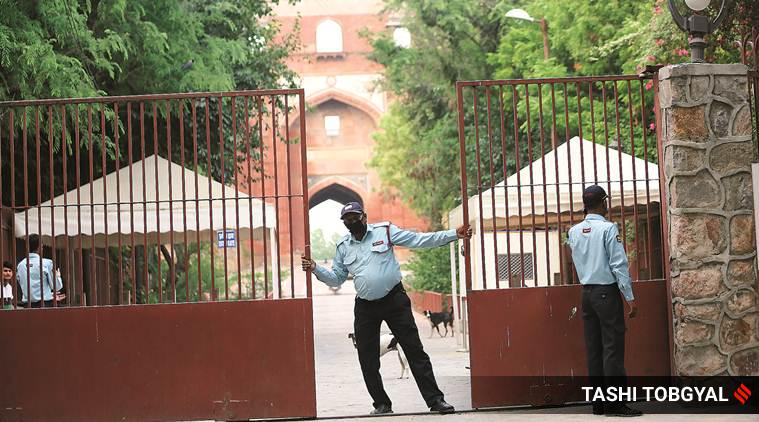 Security personnel at Delhi’s Old Fort on Thursday. The Old Fort is among the monuments set to open on July 6. (Express photo by Tashi Tobgyal)
Security personnel at Delhi’s Old Fort on Thursday. The Old Fort is among the monuments set to open on July 6. (Express photo by Tashi Tobgyal)
After a shutdown of more than 100 days, all ASI-protected monuments will reopen for the public from Monday (July 6). Union Culture Minister Prahlad Patel on Thursday said his ministry has given the go-ahead for all such monuments to welcome visitors from July 6.
There are more than 3,000 monuments under the Archaeological Survey of India (ASI), including the Taj Mahal, Khajuraho temple, Sanchi Stupa, Red Fort and Qutb Minar. The minister said the monuments will be opened in “compliance of the state and district administration”.
Amid the Covid-19 pandemic, all the monuments had been closed since Prime Minister Narendra Modi announced the first countrywide lockdown in March. As many as 3,691 centrally protected monuments and archaeological sites maintained by the ASI have been shut since March 17.
Last month, the Union Culture Ministry approved opening of 820 ASI-protected monuments that have places of worship from June 8. While the Taj Mahal remained shut, the Fatehpuri Masjid on the south-west corner of its entrance, the mosque on its premises and the Kali masjid near it were allowed to open.
SoP for opening all centrally protected monuments and museums:
These are the guidelines the government has laid down for the monuments that are reopening.
* Only those monuments/museums that are in non-containment zone will be open for visitors.
* All Centrally protected monuments and sites shall be bound by the protocol issued by the Ministry of Home Affairs, Ministry of Health and Family Welfare, as also any specific orders of the state and/or District administration.
* Entry tickets shall be issued by e-mode only. No physical tickets will be issued until further orders.
* At the parking, cafeteria etc., only digital payment is allowed.
* Visitors will have to share their phone numbers at the entrance of monuments for the purpose of contact tracing, if required later.
* There will be a cap on the number of visitors in select monuments. The number of visitors for Taj Mahal has been capped at 5,000 a day (in two slots), while that of other popular monuments is between 1,000 and 1,500.
* The visitors shall follow social distancing. The use of face cover/mask is mandatory. Entrance to have mandatory hand hygiene and thermal scanning provisions. Only asymptomatic persons are allowed.
* There shall be designated routes for entry & exit and movement within the monument. The route shall be one-way only, with a single line maintaining norms of social distancing.
* ASI can restrict access to the vulnerable and interior parts of any monument.
* Visitors shall be asked to stick to time limits inside the monument, as far as possible. The security staff inside the monument shall ensure that there is no crowding at any point.
* No group photography is allowed within the premises.
* All Sound and Light Shows and films shows at monuments shall remain suspended till further order.
* Vehicles shall be parked in designated areas. The contractor who runs the parking area shall collect the parking fee through digital payment only. No physical cash transaction is allowed.
* Guides and photographs with valid licence are allowed to work
* No food/eatables shall be allowed inside the premises.
* All the staff shall be well protected as per health protocol.
* Cleaning and sanitisation of monuments and museums, including toilet blocks, benches and frequently used surfaces, shall be done at regular intervals.